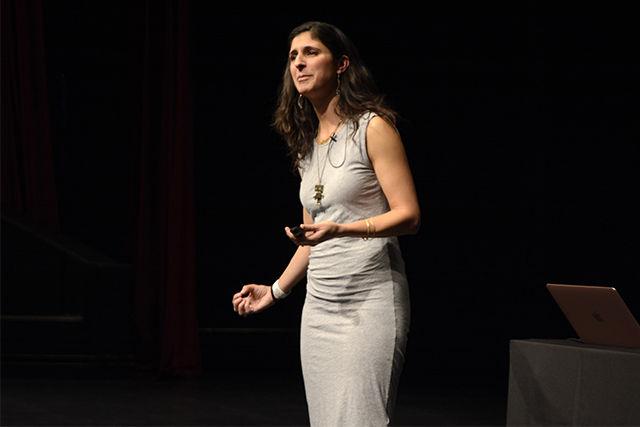
Sindy Huang
Nina Tandon, a biomedical engineer and a TED Senior Fellow, talks about the future of biology in Stewart Theatre on Tuesday. She told the audience about how technology could not only grow healthy tissue to replace diseased tissues, but also to grow sick tissue to explore how diseases work or even be used to build materials and create art.
Dr. Nina Tandon lectured on regenerative medicine and modern healthcare in Stewart Theater on Wednesday.
Tandon is a TED fellow as well as the CEO and cofounder of EpiBone, a company that claims to grow the future. EpiBone regenerates complex bone structures through modified human fat cell, repurposed into stem cells. With 3-D printed forms from CT scans of defected regions, EpiBone forms its bone implants. In its essence, the regrowth process allows patients with bone defects to use their fat cells to create personalized, naturally healing bone implants. EpiBone claims that its bone implants require less recuperation time and improved bone reformation than traditional implants.
Tandon’s lecture showcased the growing role of biology in technological and healthcare innovations. She highlighted several research studies, ranging from bricks laced with biomaterials that can repair cracks to a version of brick breaker that uses a computer cursor to move live paramecium about a playing board. During her presentation, Tandon engaged her audience by embodying her curiosity in simple and universally tangible concepts.
“We as a human species are a bit obsessed with our sense of sight,” Tandon said. “So much what science is about is making what was invisible, visible. Inside our own bodies, we have living batteries, we have broken bridges that repair themselves, we have mitochondria that convert energy at a rate 10,000 times more efficient than the sun.”
Tandon used her research in bone regeneration to lay the foundation for similar regenerative technologies, captivating students with images of laboratory-grown leather and mineral-eating bacteria. Although Tandon could not fully clarify the science behind each biological innovation, she clarified to students her concept, “wealth out of waste,” creating useful products from naturally occurring technology.
Throughout the presentation, Tandon reminded the audience about the growing influence of regenerative technology in everyday applications such as circuit design or microbe programming. In her words, a meaningful career was “a big story that you can have your small part in.”
Kobi Felton, a junior studying chemical engineering asked Tandon explain the connection between research and entrepreneurship with respect of her accomplishments as a biomedical engineer.
“I asked the question, ‘how do you take your idea in research and turn it into a company,’” Felton said. “I’m interested in entrepreneurship, so her answer about getting an MBA was very insightful. I think what she said about collaborating with different fields is really important.”
Toward the heart of her presentation, Tandon addressed the difficult ethics of playing God and modifying animal and human cells. Tandon displayed a picture of a rat used to grow a human ear transplant to demonstrate the negative aspects of developing regenerative medicine. She asserted that scientists must continue to work with others in the humanities to understand the human ramifications of research and developing technology to uphold high ethics and to help society to progress with advancing medicine.
“I think what’s most important is that we ask ourselves not can we do but what should we do,” Tandon said.
Sambit Panda, a senior studying biomedical engineering addressed the ethical issues that Tandon discussed. As a fellow biomedical researcher, he fully understood Tandon’s concerns.
“I’m pretty interested in these things, so I was really happy when they decided on the speaker,” Panda said. “I do a lot of animal research while I’m at NC State, and I thought that there were necessary questions to ask. I’m not exactly sure how to answer them; I’m sure that no one really is.”
Despite the profound implications of her research, Tandon concluded that her research intrinsically brings about self-reflection within the scientist, causing them to consider what organisms and resources must be sacrificed in order to better humankind. She concluded her presentation hopeful, with a sobering note.
“There really is no act of creation that does not involve another act of destruction.”